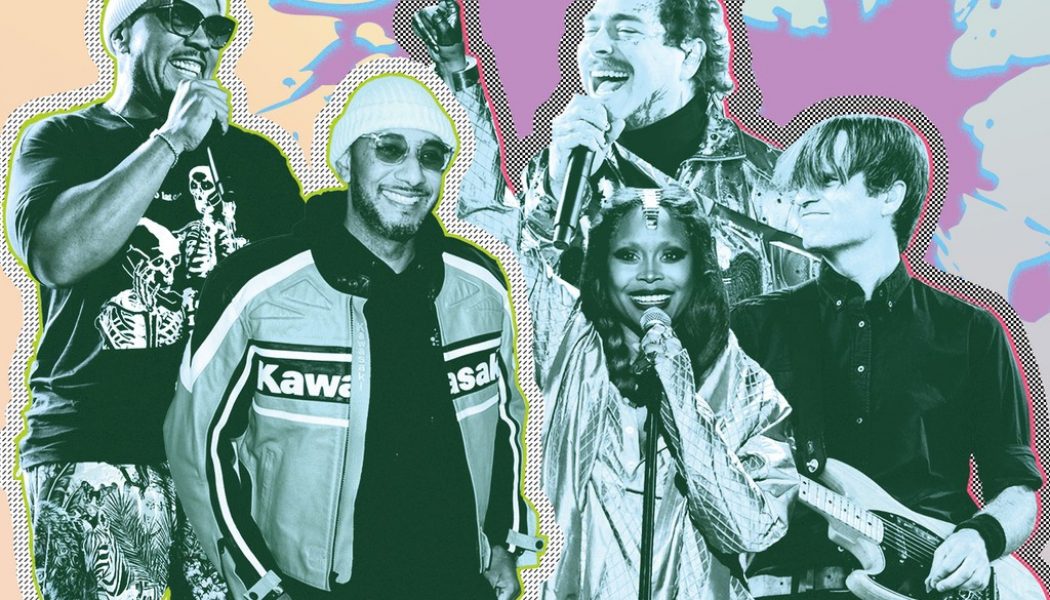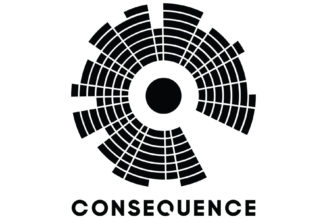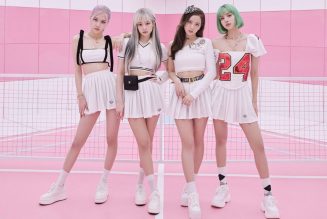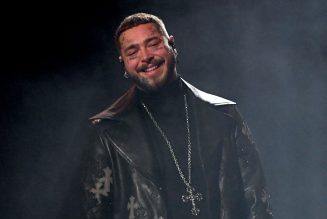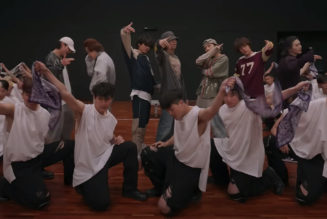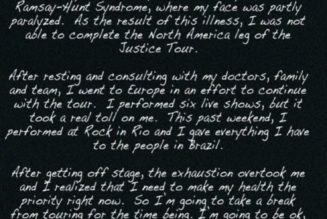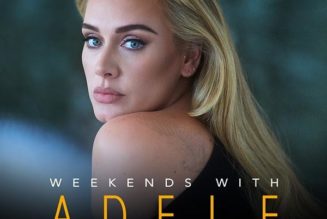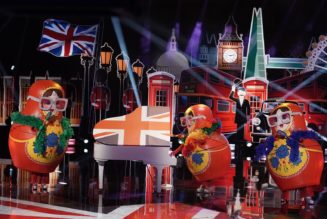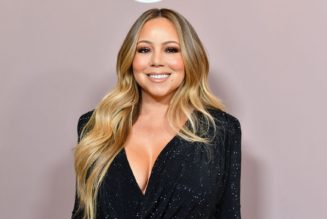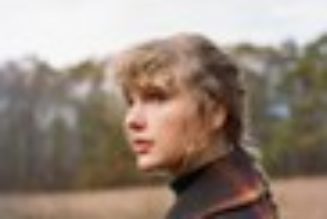
How will the flurry of at-home and in-game performances leave their mark on pop music?
“We just wanted to fuck around and have a good time,” Post Malone said, sipping from a beer can in a koozie before holding it aloft. “Cheers, fuckers!” In a thunderous 80-minute set of Nirvana covers, livestreamed from his Utah home on April 24, he was funny and loose, wearing a floral day-dress (not unlike the one Kurt Cobain once wore) and checking if his accompanying band was “hot and ready, Lil Caesar’s style.” “Let’s kick this shit in the ass,” he said, referring to COVID-19, before launching into the whiplashing riff of “Drain You.”
Post Malone styles himself as a slouchier version of a golden age axe-wielder. He’s covered rock classics and literally has a Nirvana face tattoo, but on the livestream, his guttural rasp and shredding skills proved his obsession with Rock & Roll Hall of Famers is not skin deep. It was a punk as hell. Well, with the possible exception of the Saint Laurent-branded arcade console on the countertop behind him. “I don’t think these fellows can play any better,” tweeted original Nirvana bassist Krist Novoselić. “GOOSEBUMPS!” added Courtney Love. It raised nearly $5 million for The World Health Organization’s COVID-19 response fund.
As the pandemic has put the industry on pause — and with live music’s return potentially delayed until 2021 — Post Malone has been one of countless artists trying to fill the void with livestreams. In many cases, the intimacy of isolation has deepened performances, resulting in unexpected song choices and revealing asides. Since mid-March, Death Cab for Cutie frontman Ben Gibbard’s regular acoustic sets have cut through the noise of daily “Going Live” notifications. (I dare anyone who grew up with The O.C. not to get misty at “The Sound of Settling” sung into a webcam). Instagram’s Together At Home performance series was charmingly rough around the edges, with Charlie Puth’s enjoyably dorky explanation of how he made “Attention” and lithe collar-popping and choreo from Christine and the Queens. Watching these streams, there is often a sense that artists are liberated from the golden handcuffs of having to play the hits, or at least relishing the chance to switch it up.
If only more of that energy had powered Lady Gaga’s One World concert on March 18, which took the vibrancy of artist-led streams and converted them into a traditional two-hour TV package. Aimed at a mass audience, it felt strangely static, with an array of superstars resembling the quarantine house meme come to life. (Want to room with J.Lo and Eddie Vedder? Billie Eilish and Oprah?) There were bright spots — including performances from Taylor Swift, Lizzo and Kacey Musgraves — but adapting a phenomenon born on mobile devices and social media to network television removed a crucial ingredient: A sense of stakes, that feeling of watching a performer and feeling like anything could happen in that room.
Of course, it feels churlish to be too hard on well-intentioned artists doing what they can: One World raised $127.9 million for WHO’s relief efforts. And of course the magic of a live concert, and the electric communion it creates among fans, are impossible to replicate. Given the limited means right now, nobody expects Britney Spears to drape an albino python around her neck on Zoom. Rather, today’s most successful livestreams find artists diving headfirst into the uncanny valley of digital music experiences, leaning into the weirdness of our times to create something raw, communal and wholly original.
In-game performances have attracted plenty of artists, eager to provide the kind of concert experience and visuals most fans haven’t seen before. Last month, Charli XCX headlined glitch-pop duo 100 Gecs’ Square Garden festival in Minecraft, where her avatar danced around fans’ to remixes and unreleased songs in a scene that felt like dropping LSD in a medieval-themed Lego kit — not exactly what you’d find at a regular Charli show, but one that offered plenty of thrills nonetheless. Travis Scott’s immersive Fortnite experience, Astronomical, paired a megamix of hits with fantastical morphing landscapes (and doubled as a launchpad for “The Scotts,” his instant chart-topping collaboration with Kid Cudi). And while pop-rap sensation Doja Cat might not be a typical emo festival mainstay, she brought the virtual house down with a surprise performance at American Football’s Minecraft all-dayer — the kind of booking that’s hard to imagine happening offline.
Other artists have embraced fan communities, as well as the conversations and occasional friction they inspire, to create true event-level programming at a time when many livestreams are archived and rewatchable. An Instagram showdown between legendary hip-hop producers Swizz Beatz and Timbaland attracted a modest audience of 22,000 users on March 25, but that was enough for the duo to recognize the potential of a battle series, calling it Verzuz and recruiting a class of hip-hop and R&B legends for future installments. On April 20, half a million people — including stars like Adele, Diddy and Mariah Carey — tuned in to see Teddy Riley face off with Babyface, while a joyous May 9 session with Jill Scott and Erykah Badu saw Michelle Obama, Missy Elliott and Normani pop into the fan comments to show some love, perhaps the most genuine “Stars — they’re just like us!” moment to emerge during this time. (Outside of Verzus, Badu’s quarantine series The Apocalypse has been a particular highlight, with dazzling renditions of fan favorites and eye-popping set-ups that would rival anything in the MOMA atrium.)
Putting a new spin on old favorites is a foolproof move during these times, especially as nostalgia appears to be a comfort. According to a recent Nielsen Music/MRC Data survey about consumer habits during the pandemic, 62% of music fans are revisiting treasured albums, which perhaps explains why pop fanbases have been mobilizing to get Britney Spears’ Glory and Madonna’s Bedtime Stories shooting up the iTunes chart. Artists would do well to try more niche performances that are both fan service and a chance to flex other creative muscles. How about Lana Del Rey doing a front-to-back rendition of Joni Mitchell’s Blue? She’s hinted at a covers album before, and Mitchell is her hero. What about a Nicki Minaj mixtapes-only set, from “Warning” to “Itty Bitty Piggy”? Or, in the wake of her Lover Fest cancellations, it would be a thrill if Taylor Swift were able to perform with recent collaborators like Jack Antonoff, Dixie Chicks and Annie Clark on pay-per-view. (She certainly knows how to round up special guests, and her sets’ surprise songs — a Swift trademark — could be fan-voted by viewers.)
There’s no reason any of those ideas couldn’t work months down the line, as society opens back up and remote set-ups become less necessary. After all, the industry was already trending toward more livestreams before the pandemic: Last year, Coachella’s streams rose by 90%, with 82 million viewers perhaps grateful to not deal with the desert festival’s dust and flower crowns. A 2017 study by New York and Livestream also showed that 67% of viewers are more likely to buy event or concert tickets after watching that same event on a livestream. (It figures: Consider the buzz around Beyoncé’s “Beychella” performance even before it was released as Homecoming.) As the livestream boom matures, its biggest success stories could prompt other artists to make their shows feel more interactive and informal, chipping away at the fourth wall between entertainer and audience.
Pop would be much less fun without its fancy packaging: the expensive looks, marketing and colorful videos that ensure the omniscience of today’s chart juggernauts. But as the quarantine era’s sharpest streams have embraced its limitations with flair, the artists behind them are setting the stage for what could be the decade’s new normal. On The Late Show With Stephen Colbert, Haim let a spectral post-dubstep hush descend over their new track “I Know Alone,” which they played in separate rooms. Dua Lipa, meanwhile, played “Don’t Start Now” on The Late Late Show with James Corden in split-screen with dancers, backing vocalists and a three-piece band. While elements of these performances were likely pre-recorded and meticulously produced, there was a collaborative ethos and an unfussy spirit that felt timely, even a little revelatory. Seated at home, Lipa wore her hair pulled back, stuck out her tongue and let out a spontaneous-seeming “whoop” during the bridge, as synths exploded like a glitter bomb. It was the most inventive late-night performance of the year so far. You didn’t miss the razzle-dazzle at all.
